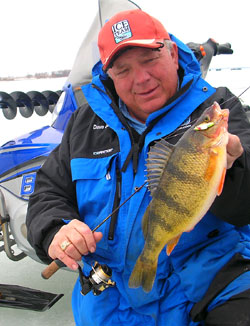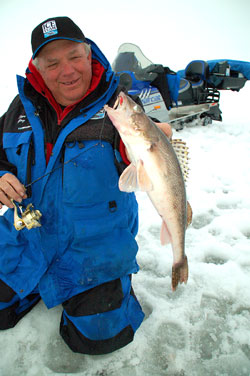 It’s important to understand both the horizontal and vertical dimensions of mobility.
It’s important to understand both the horizontal and vertical dimensions of mobility.
The whole subject of mobility in ice fishing goes way beyond how many holes you can drill in a day. Or how many GPS waypoints you can drill a couple holes on in a day.
Fishing fast, fishing with a purpose. That’s what mobility means, says Dave Genz, the man who revolutionized the sport some thirty-plus years ago.
“Fishing fast is the key,” says Genz. “You have to get through the dead water quickly. That’s why I always talk about lures that fish heavy for their size.
“There might be 5, 10, 20, even 30 feet of dead water you aren’t catching fish in. You can’t waste time getting down to that productive level.”
It has taken years for Genz to get a chance to explain what he means by mobility, and this is an important concept. In other words, there are both horizontal and vertical dimensions to ice-fishing mobility.
‘Horizontal’ means how many spots you can visit during your outing. You might be walking from spot to spot, or using motorized transport like an ATV, snowmobile or vehicle.
‘Vertical’ means how quickly you check from the surface to the bottom at each spot. And once you identify the productive depth zone, this vertical component of mobility becomes the most important factor influencing how many fish you catch before heading to shore.
For right now, we’ll concentrate on the vertical.
 The Secret to Good Verticality
The Secret to Good Verticality
We arrive at the core concept for the moment: how do you do the best job possible of fishing quickly, while still making sure your presentation looks real, looks alive, gets big fish to come over and eat it?
This is a heckuva good question, and how you do handle this goes a long way to determining how many fish you are going to catch. Even if we agree that it’s a good idea to get your bait quickly from the surface down to the fish zone, there are limits.
If the only goal was to see how fast you could drop something into 22 feet of water, the answer would be a three-ounce jig. It would drop down there faster than the fish could follow it with their eyes, and hit with a thud rivaling an atomic bomb, producing an impressive dust cloud spreading out from ground zero.
What would happen, in that extreme case, is that nearby fish would flee for their lives– or at the very least, would not look upon your offering as something to eat. You get the idea: the goal, really, is to quickly get your bait through unproductive depth levels, while at the same time offering the illusion to nearby fish that what they see would be a good thing to suck in all the way to the back of their throat.
There is every shade of grey between too slow and too fast, and in some cases, you are forced to take your time getting into fairly deep water with something that essentially floats the whole way down. If that’s what it takes to catch fish at the moment, do that.
“But at the start of the day,” says Genz, “you’re better off fishing fast until you find that out.”
Genz, when he is asked to explain the main goal: “Usually, you can see that the fish are down there, on the Vexilar or your Aqua-Vu. Even when the fish are suspended, they will show up when they come swimming through underneath you. So it’s not usually a mystery about what’s down there, if you have these modern tools.
“But, like I said, there’s this dead water, a lot of times, between the surface and where the fish are. That’s why, a long time ago, we started using small jigs that fish heavy. We wanted the jig to show up on the Vexilar, but we didn’t want to wait five minutes for it to get down to the fish. You have to get through the dead water quickly.
“But you can’t just open the bail and let (the bait) crash to the bottom. You want to stop it before it hits bottom a lot of times. You want to stop it, and then slowly fish it down that last little bit as it gets into the fish zone.
“Many times, if you stop (your bait) above the pack, the bigger fish will rise up out of the group and crush it. If you let it get all the way down into the group, it’s the small fish that are pecking at it. We’re talking about biters now, fish that are ready to bite, especially on that first drop down a new hole.”
There is more to say (there always is with fishing), including the importance of finding the action those fish want, on that day. Genz is famous for his ‘pounding’ presentation, the rapid vibration of the bait, as it stays essentially in place. This is a skill important to learn, and we’ll write about it yet this winter.
But for now, Dave wraps up this subject by reminding us how important it is to not just drill a lot of holes, but to fish each one efficiently as we try to put together a productive pattern.
“You’re either going fishing, or catching,” says Genz. “I don’t like to spend a lot of time just plain fishing. That’s not catching. The act of going fishing just means going to your best spot, just getting to it.
“When you get to the spot, fish it quickly. See if any fish are there right now. If you fish for a few minutes and don’t catch anything, don’t stay there. Go to a new hole and find biters.”
Note: Dave Genz, known as Mr. Ice Fishing, was the primary driver of the modern ice fishing revolution. For more, including his instructional DVD on bluegill fishing, go to www.davegenz.com, and www.iceteam.com.










